
This is the grand, dreamlike vision of central Port-au-Prince that President Michel Martelly says will replace what was toppled when a 7.0-magnitude earthquake left much of Haiti’s capital in ruins on Jan. 12, 2010. Sketched plans look more like a wealthy Miami suburb than the gritty downtown of old that housed both state institutions and shabby tenements.
“These plans will take a long time to finish, perhaps another 10 years,” says Harry Adam, executive director of the government agency that is responsible for the construction of public buildings and housing. “But I think it’s realistic. We can do it.”
Demolitions began in June for construction of an “administrative city” covering 30 hectares (75 acres) downtown.
But the plan hailed as a sign of post-quake rebirth by some residents has also set off a firestorm of criticism for creating a new wave of homelessness, after many poor renters were given just minutes to vacate their dwellings before bulldozers arrived.
While there are no available figures on the number of people left homeless by the demolitions, the city center has become dotted with new encampments of tarp shacks in recent weeks. Hills of rubble left by bulldozers have grown so large it almost looks like a fresh quake just hit.
Bitter quake survivors, some who only recently were moved by aid groups from squalid tent camps to downtown apartments, are back to living beneath tarps or staying with friends.
Read more at abcnews.go.com


